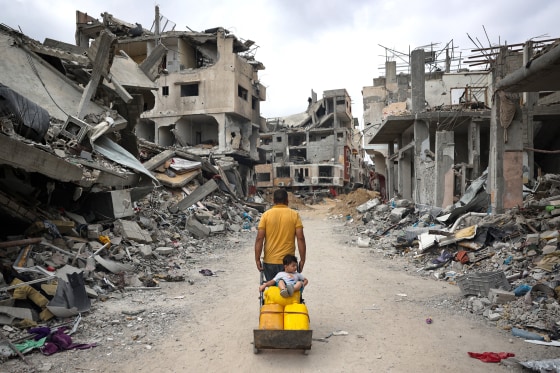The 'lifelines' that could save Hamas from its worst crisis yet
The terrorist organization is suffering from a financial collapse, but the entry of aid trucks and mounting international pressure could help it survive. At its lowest point, Hamas is ramping up psychological warfare efforts, aiming to end the war without releasing all of the hostages. Without a decisive defeat, the countdown to the next war will begin. Meanwhile, key operatives remain alive and continue orchestrating terrorist activity.

Though their comments appeared to refer broadly to the crisis in Gaza, their statements implicitly confirmed that the organization itself is in its worst state ever. This is prompting Hamas to keep negotiating over a hostage deal and to continuously seek ways to regroup.
With the likely assassinations of Muhammad Sinwar and Muhammad Shabana in Khan Younis, Gaza is now being managed by a second-tier command structure made up of brigade commanders and mid-level staff officers. The apparent new head of the military wing is Az al-Din Haddad, whose authority has expanded from the Gaza City brigade to the northern part of the Strip.
Known as "the ghost," Haddad has managed to evade Israeli forces since the war began, despite being part of the inner circle that planned the October 7 massacre. He is working alongside Raed Saad, head of Hamas' production division, who survived an assassination attempt in northern Gaza. Both are also grappling with the loss of control over large parts of the Strip.
The surviving figures - for now
Another key figure still at large is Tawfiq Abu Naim, a former close associate of the now-dead Yahya Sinwar, who served as head of Gaza's internal security apparatus before the war. While most senior officers under Abu Naim in the police and interior security services have been killed, he remains alive.
These agencies have been consolidated into a single entity called "the operational mechanism," which existed in Gaza roughly 20 years ago and helped Hamas take over the Strip from the Palestinian Authority. This restructuring reflects a decline in capabilities: the new force consists of 5,000 operatives from various branches, less than half the size of the pre-war internal security apparatus. Even so, Hamas is trying to "streamline" operations and adapt to the circumstances, primarily to better instill fear and maintain control over the population amid rising protests.
Other significant commanders include Muhammad Awadeh, in charge of intelligence, and Imad Aqel, responsible for the home front. Sources within Hamas report that new brigade commanders have been appointed to replace those eliminated, but they now command a significantly smaller and less trained force.
Many of the new recruits are minors or inadequately trained compared to the terrorist army Hamas maintained prior to October 7, hardly just "guys in flip-flops," as the group's years of training footage shows.
One of Hamas' most wanted men is Hudhayfa Kahlut, better known as Abu Obeida. Contrary to rumors following the strike on Muhammad Sinwar, it appears that the military wing's spokesperson was not present in the underground facility that was hit. Several junior Hamas spokespersons involved in psychological warfare have been killed in Gaza since the war began, but the propaganda apparatus is still functioning, supported by the group's foreign leadership.
At the core: financial crisis
The core of the crisis is financial. The London-based newspaper Asharq Al-Awsat reported over the weekend that for the past four months, Hamas officials have received only a few hundred shekels each, and members of the military wing have not been paid at all.
In addition, the organization has struggled to fill key posts after several of its financial leaders were killed. Ismail Barhoum, head of the finance division, was eliminated in March, and numerous money changers were also targeted. Just last week, the IDF destroyed the Al-Qahira money exchange office in Gaza City, which Hamas used to store and transfer tens of millions of dollars. Still, it's likely that the hundreds of supply trucks allowed in by Israel have enabled Hamas to profit substantially from looting and selling the goods.
Other terrorist organizations in Gaza have also taken note of Hamas' weakness. The Saudi-owned Al-Hadath TV channel reported this week that these groups pressured Hamas to accept Egypt's interim cease-fire proposal in March, which included a partial truce and the release of about eight hostages in an initial phase. They also demanded the formation of a joint negotiating delegation. These groups include Palestinian Islamic Jihad, the Popular Front for the Liberation of Palestine, the Resistance Committees, and factions of Fatah's al-Aqsa Martyrs Brigades.
At this nadir, Hamas is intensifying its psychological propaganda campaign. The goal is for international and domestic Israeli pressure to force an end to the war, without a full hostage release, allowing Hamas time to recover.
Despite its hardships, Hamas still has the means to achieve this. Its foreign leadership remains largely unscathed and is capable of raising vast sums of money. Senior commanders remain in Gaza. If this scenario materializes and Hamas is not decisively defeated, the countdown to the next war will have already begun.

No comments:
Post a Comment